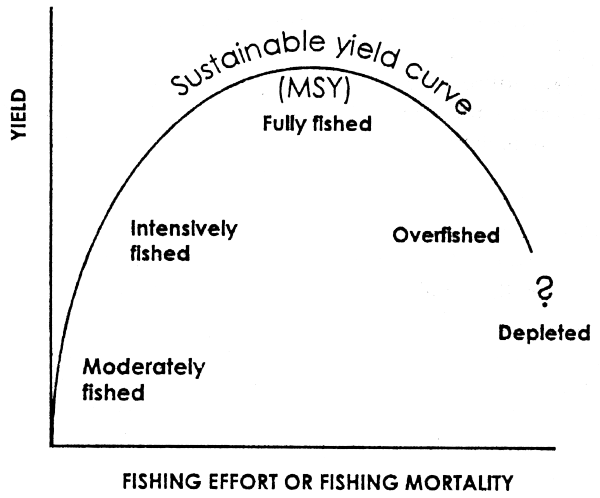MSY objective
The EU adopted a Maximum Sustainable Yield (MSY) approach to fish stock management as part of the 2013 reform of the Common Fisheries Policy. But applying the MSY-strategy has proved to be a substantial challenge.
What is Maximum Sustainable Yield (MSY)?
- It is a harvest strategy widely adopted in global fisheries, including the EU Common Fisheries Policy.
- It should act as an interim step toward more robust ecosystem-based management.
- It is a fisheries exploitation concept that seeks the largest long-term predictable catch possible from a stable, ‘equilibrium’ environment.
Global use and interpretation of the MSY approach has evolved in complexity since the early 20th century and its implementation is still hotly debated. Scientists continue to challenge MSY as a valid management objective from economic, societal and biological perspectives.

The EU adoption of MSY
The EU’s interpretation aligns with prior international commitments in 2002 and 2012 to achieve MSY by 2015, where possible, and by 2020 at the latest. It is reiterated in the UN’s 2015 Sustainable Development Goals.
The EU interpretation is also more ambitious, seeking to restore and maintain populations of fish stocks “above biomass levels capable of producing MSY” (CFP Article 2.2)
However, EU has introduced more flexibility in meeting this objective by introducing MSY-ranges for stocks managed under multi-annual management plans (MAPs). These ranges are provided in the scientific advice that informs the decision-making on fishing opportunities. In practice, this means that the decision-makers can decide to be less certain about stock recovery by choosing an option in the range that allows more fishing. This way overfishing may continue and there is a risk that the fish stock biomass may decline, instead of increase. The MSY-ranges were first introduced in the Baltic Sea Multi-annual plan (See Annex 1).
MSY and policy
MSY is a maximum value beyond which stock productivity is assumed to decline. Given the uncertainty in fisheries stock assessment, attempting to exploit a stock at a rate which can produce MSY (FMSY) can easily lead to overfishing the stock in terms of both growth and recruitment.
Furthermore, maximising yield as a policy excludes the market impact on various fleet sectors, frequently creating an unprofitable fishery characterised by a technological race to catch more of a decreasing stock and the prioritization of larger scale industry over more diverse community-based fisheries. The value of the CFP’s objective to fish below FMSY in Article 2.2 is the potential to prevent this race to the last fish.
The current challenge for policy makers is to determine an appropriate exploitation rate below FMSY to establish equitable and profitable fisheries and to refrain from using the loophole for overfishing that was introduced through the MSY-ranges with the regional management plans.
Last updated: February 10, 2021
Recent publications
Joint NGO feedback to the European Commission on the “Sustainable fish...
August 4, 2023
Joint response to the European Commission’s public consultation on the progress towards achieving more sustainable fisheries, the state of fish...
Joint NGO recommendations on Baltic Sea fishing opportunities for 2024
June 19, 2023
The Baltic Sea ecosystem is in severe distress and the major commercial fish stocks have never been in worse condition. In...
Joint NGO recommendations on Baltic Sea fishing opportunities for 2023
June 15, 2022
In October 2022, EU fisheries ministers will agree on fishing opportunities in the Baltic Sea for 2023. As the deadline to...
Joint NGO recommendations Northeast Atlantic fishing opportunities 202...
October 14, 2021
NGO signatories of this document wish to present our recommendations on the setting of fishing opportunities for north east Atlantic...